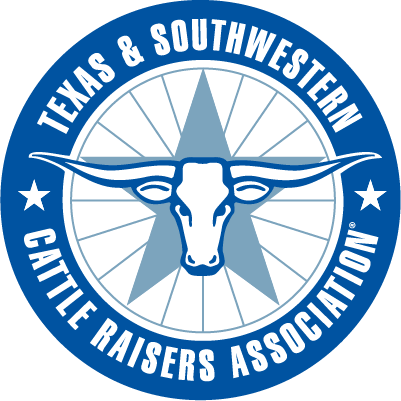When Amber Gonzalez and her husband first started dreaming about building a ranch, they tried to envision what type of cattle would graze their pastures.
Without hesitation, her husband Raul Gonzalez Jr. said, “I want to raise Brahman cattle.” Gonzalez laughs when recalling the moment. “Brahmans?” she answered him. “People don’t even think they’re edible!”
Though first-generation ranchers themselves, Raul’s great-great-grandfather ran Brahman cattle in Mexico, planting the seed of a dream that would one day take root in Texas.
In 2015, the couple took their initial steps forward by purchasing land in Bastrop and buying their first registered Brahman heifer shortly after — laying the foundation for what would become La Estancia Ranch.
Today, the Gonzalez family manages a herd of about 50 head, mostly purebred polled Brahman, with some F-1 crosses to meet market demand. They launched Brahman Darlin’ Beef in 2023 to market beef directly to consumers in nearby Austin. And in pursuing their passion, they’re proving the stereotype “tough, Brahman beef” belongs in the past.
Shaking the stigma
Todd Thrift, Ph.D., beef cattle Extension specialist and professor at the University of Florida, agrees Brahman and Brahman-influenced cattle have a history to overcome when it comes to carcass traits. “A lot of the perception about Bos indicus beef quality is based on genetics from 30-40 years ago,” he says. “Today’s Brahman genetics are a whole different story.”
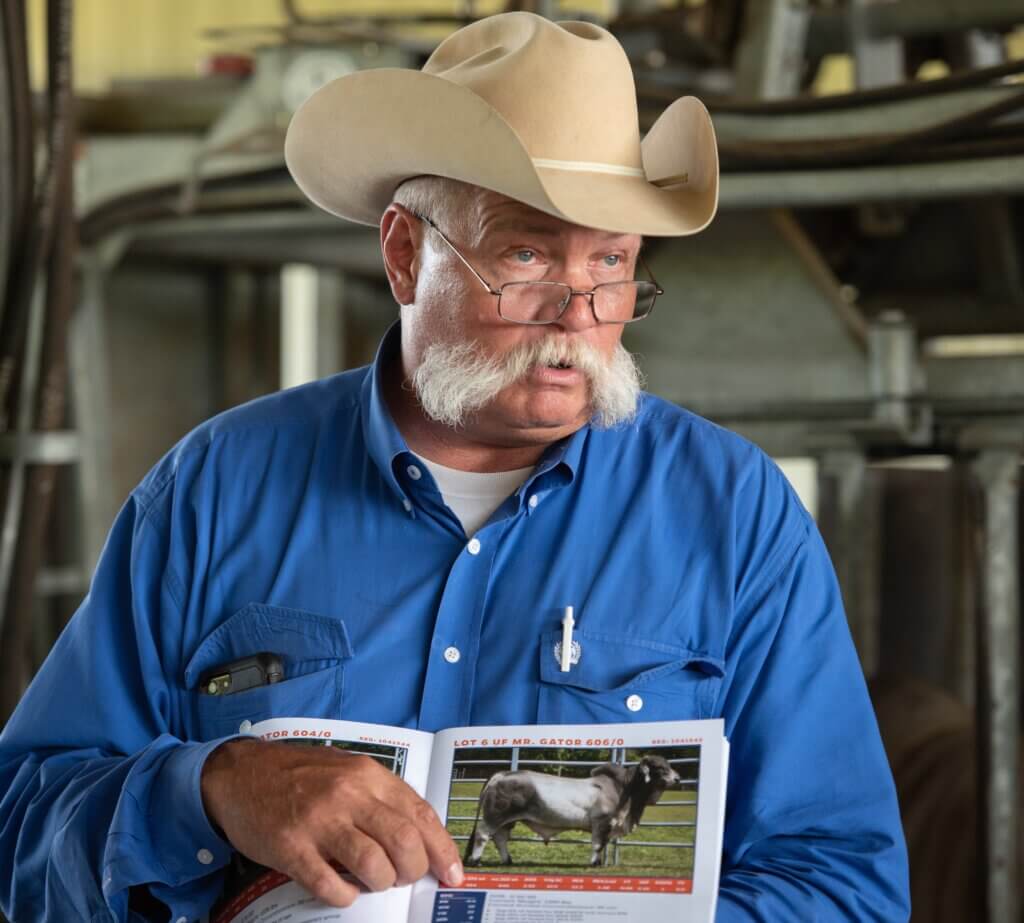
The Brahman breed was originally introduced into the U.S. for their adaptability in hot, humid and parasite-heavy environments. In the Southeast and Southwest, where British breeds tended to struggle, Brahmans thrived. But their heat tolerance came with a catch: leaner carcasses, lower marbling and sometimes less tender beef.
“In the 1970s and ’80s, when a lot of that data was being collected, Brahman cattle hadn’t been selected with carcass traits in mind,” Thrift shares for perspective. “They were being selected for survival. But just like Angus and Hereford have been improved over the years, so have Brahmans. The science and the cattle are both different now.”
Results from the Florida Fed Beef Challenge, which was conducted by Thrift from 2019 to 2023 on around 615 head, found cattle with Brahman influence averaged just under low Choice, with about half grading Choice or higher, and had tenderness scores nearly identical to retail Choice beef. Steers with less than or equal to 50% Brahman influence were no less tender than cattle with 0% Brahman, showing that using a half-blood cow provides adaptability while still producing highly acceptable beef.
On a national scale, American Brahman Breeders Association is dedicated to measuring improvements in carcass quality, adding selection tools like the $BULL index, which was launched in 2023 and prioritizes end-product merit, carcass traits and genomically enhanced EPDs for marbling and tenderness.
Science is catching up with the story cattle raisers like the Gonzalezes are living every day. Ultimately, their family’s goal is to produce cattle that grade Choice and higher, and data is part of that process.
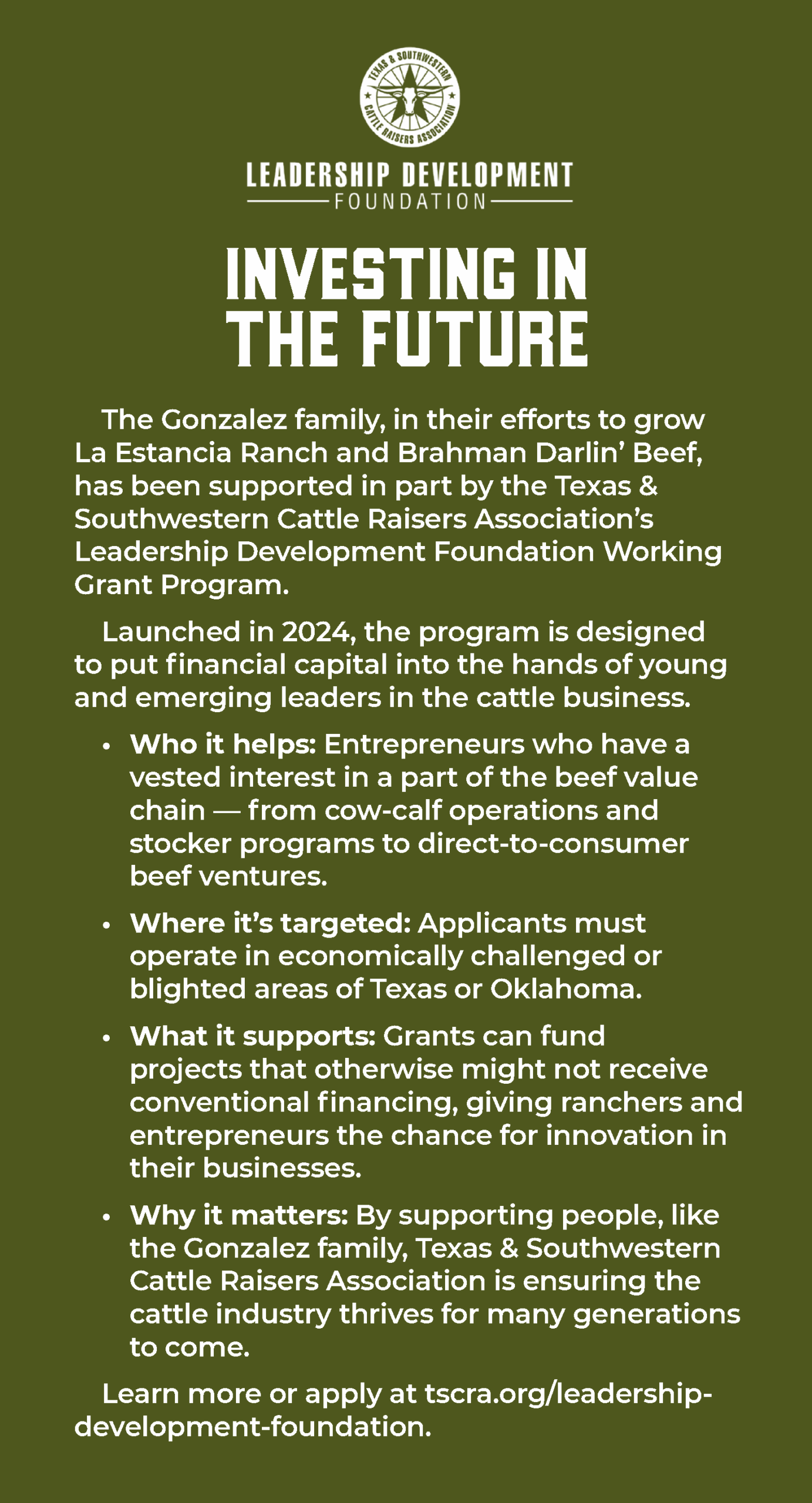
In the last few years, they have improved from less than 60% grading Choice to about 85% today, progress they credit to carcass scans, closely tracking bloodlines and intentional breeding decisions that emphasize both feed efficiency and beef quality.
That growth has been supported in part by the Texas & Southwestern Cattle Raisers Association’s Leadership Development Foundation Working Grant Program, which awarded funding to the Gonzalez family.
The program is designed for beginning or expanding ranchers looking to grow a beef industry business. The grant allowed them to purchase equipment critical for safely working their cattle and collecting performance data, which Amber says has elevated their operation.
“It took a financial weight off our shoulders. I am forever grateful to anybody who had a part in giving that to us,” she says. “It’s one thing to raise pretty cattle, but if they don’t eat well, that’s not the future.”
Better tools are helping producers everywhere hit higher marks at a faster pace.
Thrift echoes how these advancements in technology now make it possible to select for heat tolerance and carcass quality at the same time, something that was not achievable a decade ago. Selection indexes, for example, now incorporate adaptation and carcass traits. Other tools, like genomic testing, ultrasound scans and carcass EPDs, make for smarter selection decisions.
“You don’t have to sacrifice adaptation to get quality; you can have both,” Thrift assures.
“That means a producer in Texas or Florida can produce animals that thrive in heat and humidity but also have strong marbling genetics. Crossbreeding is really the key. Brahmans have always been a crossbreeding common denominator.”
The cow herd at La Estancia Ranch is a testament to having the best of both worlds. Gonzalez explains their program is built around balance, with emphasis on fertility, mothering ability, performance and carcass quality. This approach produces cattle that perform in challenging conditions while maintaining health, tolerating heat and converting feed efficiently.
Crossbreeding is another piece of the puzzle. “We’ve used crossbreeding to hit different markets, but Brahman influence is always at the core,” Amber says. “Everything gets better when you breed it with a Brahman.”
Thrift points to examples like crossbreeding Brahman and Angus to combine heat tolerance, fertility and carcass quality. He says Brahman-influenced cattle generally perform well in warm climates during the stocker phase, where stress often hinders other cattle. In the feedlot, with proper selection and management, they are also able to reach the same carcass endpoints as other breeds.
This combination of health, efficiency and adaptability is becoming more critical as shifting weather patterns put new pressures on beef production. “With climate change and rising heat stress, Bos indicus genetics will only become more valuable,” he adds.
Better beef
To showcase what the breed can offer in terms of beef quality, the Gonzalez family leverages a direct-to-consumer market for their Brahman-centered cattle.
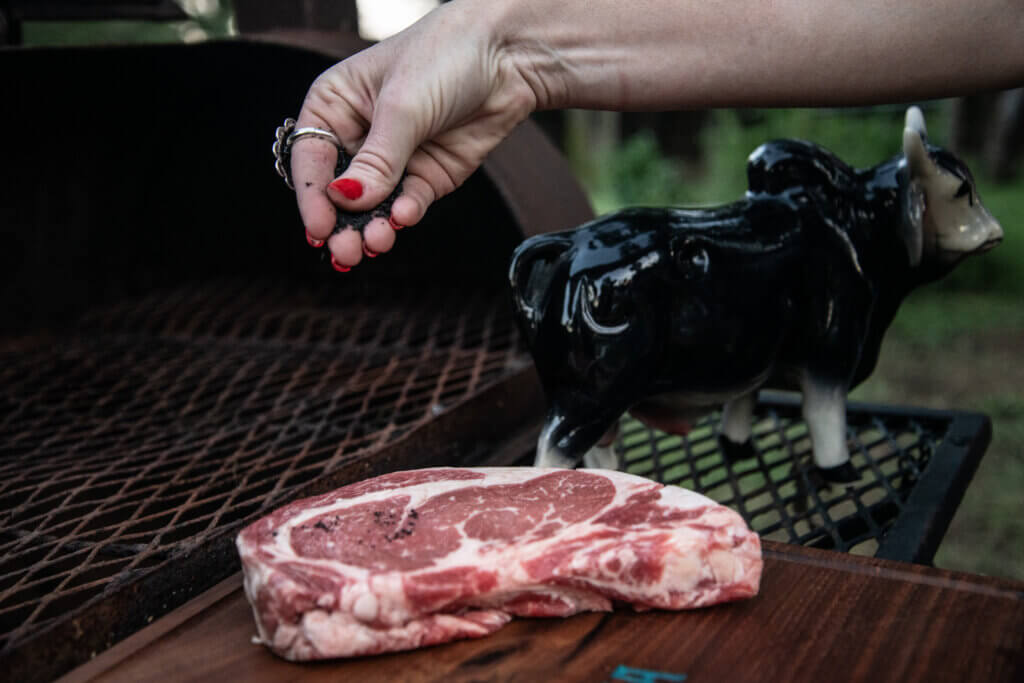
Brahman Darlin’ Beef raises resilient, efficient cattle that serve up tender and flavorful beef. Their cattle are processed just 20 minutes down the road at Legacy in La Grange, allowing the family to stay closely connected to how their beef is handled from pasture to plate.
Marketing their beef directly to consumers allows the Gonzalezes to connect with buyers firsthand, often challenging their expectations about Brahman-influenced beef.
Their customer base is mostly in the Austin area and includes food enthusiasts, fitness-minded individuals and families. Amber says that while the fitness crowd appreciates the leanness, almost everyone admits they didn’t expect the beef to taste as good as it does.
“Our customers come back saying it’s tender, it’s flavorful, it’s different,” she says. “And I think that surprises people.”
She recalls one customer’s reaction, who shared, “‘This can’t be Brahman. It’s too tender!’” Amber laughs, “That’s the best compliment we can get.”
Thrift says consumer taste panels show the same phenomenon. He observes when consumers don’t know what they’re eating, Brahman-influenced beef often performs just as well as other breeds.
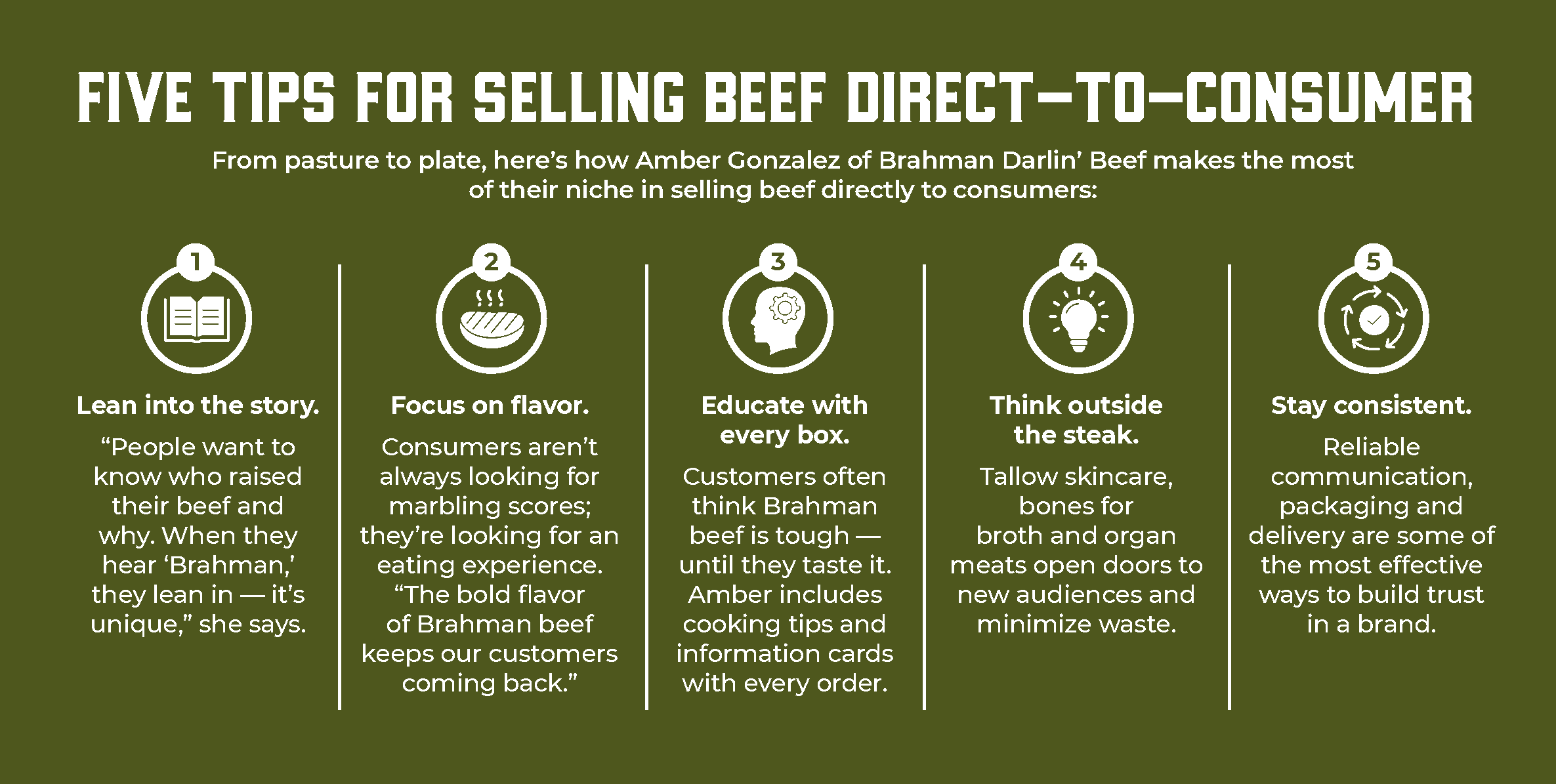
Shifting consumer perception can be more challenging than changing Brahman-based beef itself, but the adaptability on the ranch and in the market reflects the nature of the cattle.
“Brahmans have always been about adaptability,” Thrift says. “Now we’re just adapting the narrative, too.”
For the Gonzalez family, education is part of the mission to rewrite the breed’s story. Direct marketing gives them the opportunity to frame Brahman beef differently. When Amber interacts with customers, she shares the history and adaptability of the breed.
“It’s not just beef — it’s heritage, it’s sustainability, it’s something unique,” she says. “People love the idea of eating a steak that comes from a breed built for Texas conditions. Once they taste the beef, the story sticks.”
The appeal of Brahman beef isn’t limited to Texas. Around the world, consumers in Latin America, Asia and the Gulf Coast regions heavily value Bos indicus cattle. According to Thrift, many countries regard Brahman as synonymous with quality because of its adaptability. “The U.S. has an opportunity to tap into those export markets by branding Brahman beef not as a compromise, but as a premium product,” he says.
Amber sees the same opportunity, too. “We’ve had customers from other countries who tell us, ‘This is what we grew up eating.’ For them, it’s not new — it’s nostalgia, and that’s powerful.”
A life they love
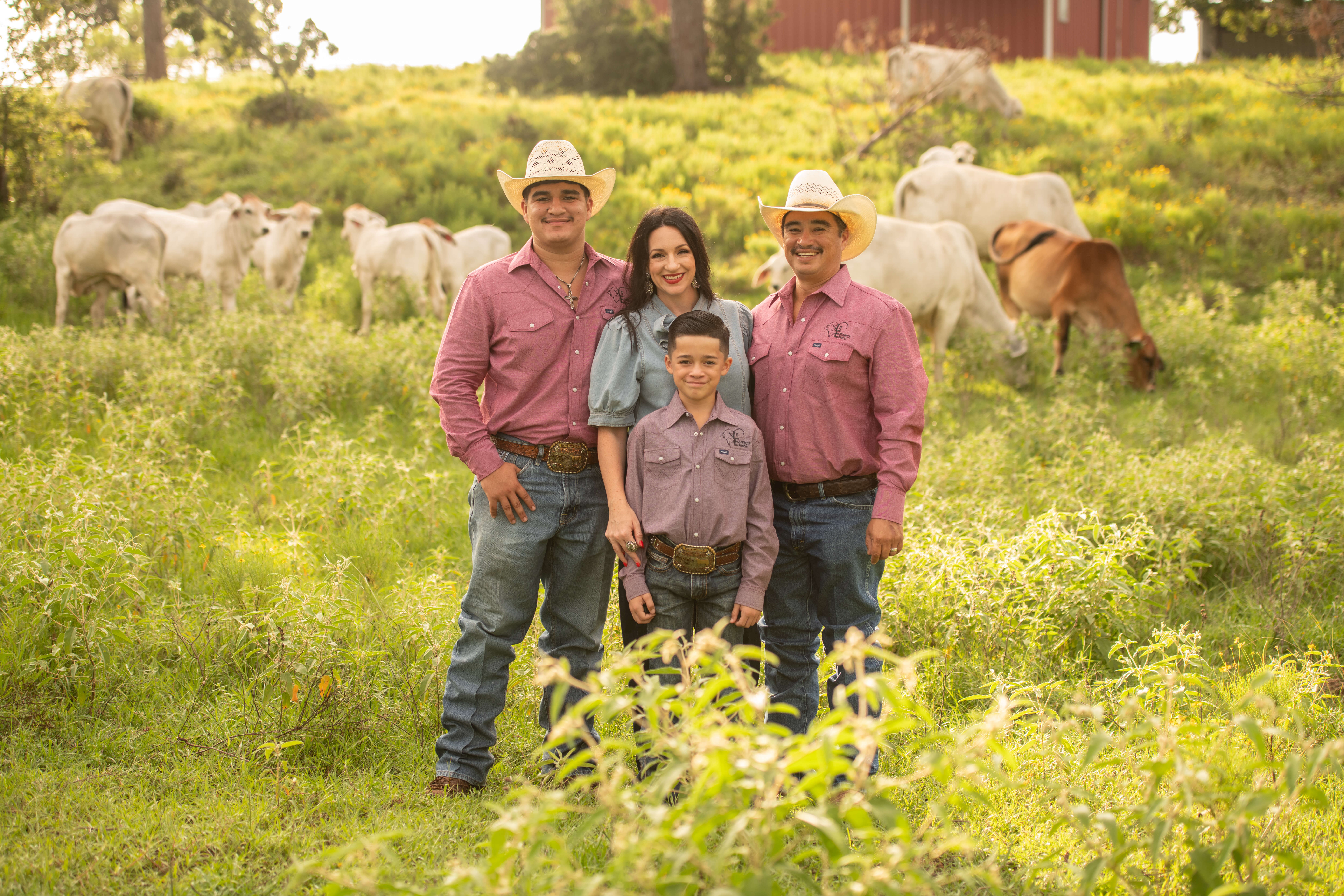
Looking ahead, Brahman Darlin’ Beef isn’t stopping at steaks and ground beef. They’ve launched a line of skincare products using beef tallow. “It’s just another way these cattle provide for us,” Amber says.
Most importantly, she sees Brahmans as part of her family’s legacy.
She says the hope is Brahman Darlin’ Beef is not just a business, but a way of life that can sustain future generations. That vision, which blends heritage, hard work and a commitment to better beef, is what keeps the family pushing forward even when the challenges seem steep.
Adam Gonzalez, the family’s oldest son, is already charting a future in ranching. He recently started his senior year of high school and has his sights set on enrolling in Texas Christian University’s Ranch Management program. Reagan, the younger brother but equally invested, is growing up with cattle work as second nature.
“We’re putting blood, sweat and tears into everything now to build a legacy for our kids, our grandkids and beyond,” Amber says. “We want to show the next generation that Brahmans are the future, not the past.”
—-
###
